Scottish Health Survey 2016 - volume 1: main report
Statistics relating to the health of people living in Scotland.
1 Alcohol
Linsay Gray, Alastair H Leyland
Summary
- The proportion of adults drinking above the recommended maximum of 14 units per week fell from 34% in 2003 to 25% in 2013 and has stayed at a similar level since (25% in 2014 and 26% in 2015 and 2016).
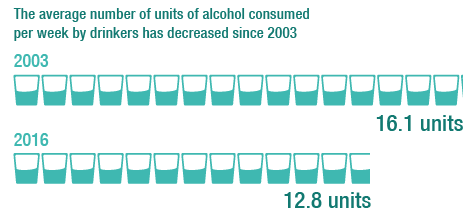
- Male drinkers were twice as likely to drink above the recommended maximum of 14 units a week than female drinkers.
- The percentage of adults reporting that they do not drink alcohol increased significantly from 11% in 2003 to 16% in 2013, and has settled at that level since.

- More adults reported not drinking alcohol in the most deprived areas (26%) than the least deprived areas (11%) (age-standardised).
- Those in the least deprived areas drank on more days on average (2.9 days) than those in the most deprived areas (2.3 days).
- Male drinkers consumed significantly more alcohol on their heaviest drinking day than female drinkers in 2015/2016 combined (8.4 units compared with 5.9 units respectively).
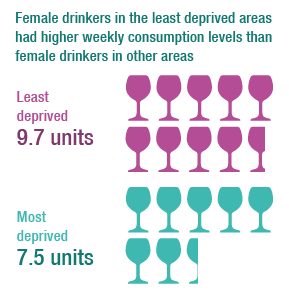
- The average number of units of alcohol consumed by adults on their heaviest drinking day fell from 7.7 units in 2003 to 6.9 units in 2013, and has remained at a broadly similar level since then (7.3 units in 2016).
- Drinkers aged 75 and over consumed less alcohol at one time, but drank with greater frequency, on average, than younger drinkers who tended to consume greater volumes of alcohol in fewer drinking sessions.
1.1 Introduction
The misuse of alcohol is recognised as a major issue in Scotland, carrying a risk of physical and mental health problems, as well as potential negative social consequences. Alcohol is now 60 per cent more affordable in the UK than it was in 1980: it is possible in Scotland today to exceed the new lower risk guidelines for alcohol (14 units per week) for less than £3[1]. The consumption of excessive quantities of alcohol leads to increased risks of high blood pressure, chronic liver disease and cirrhosis, pancreatitis, some cancers, mental ill-health and accidents[2] . The World Health Organization (WHO) cites alcohol as one of the largest risk factors for ill-health in wealthy countries, along with tobacco use, obesity and high blood pressure[2]. It also identifies higher levels of alcohol dependence and alcohol use disorders in the UK than across Europe as a whole[2].
A report published in 2009 attributed 5% of deaths in Scotland to alcohol[3]. Alcohol-related mortality increased between 2012 and 2016, with 1,265 alcohol-related deaths in 2016[4]. Whilst this remains lower than in any of the years from 2000 to 2010[5], it is around double the figures in the early 1980s. There are more than 94,500 GP consultations and around 35,000 hospital stays each year are for alcohol-related problems[6,5,7]. Although the rate of alcohol-related hospital stays has declined over the past 8 years, in 2015/16 the rate was four times higher than in 1981/82[5]. Alcohol-related morbidity and mortality are not evenly distributed throughout the population and the burden is greatest among those living in the most deprived areas[6,8,9]. Analysis of data from the Scottish Health Survey (SHeS) has shown that disadvantaged social groups have greater alcohol-attributable harms compared with those from advantaged areas, even after accounting for factors such as obesity, smoking status as well as different drinking patterns[10].
The harms associated with alcohol misuse are not restricted to those consuming alcohol, with potential impacts on others of injury, neglect, abuse, crime, and from concern for or fear of family members. A report published by Alcohol Focus Scotland in 2015 estimated that 1 in 2 people in Scotland are harmed as a result of someone else’s drinking[11]. The relationship between alcohol and crime is also well documented. In the 2015 Scottish Prisoner Survey, 41% of prisoners reported being drunk at the time of their offence, although this represents a fall from 45% in 2013[12]. In 2006, it was estimated that alcohol is involved in 70% of assaults requiring treatment at A&E[13].
Misuse of alcohol also has a negative impact on children with an estimated 36,000 to 51,000 children living with a parent (or guardian) whose alcohol use is potentially problematic[14].
According to the Scottish Schools Adolescent Lifestyle and Substance Use Survey (SALSUS) 2015[15] there has been a considerable decrease in the proportion of those aged 15 who reported drinking alcohol in the last week, from 34% to 17% between 2010 and 2015. Only a very small proportion of those aged 13 had drunk alcohol in the last week, decreasing from 14% to 4% over the same time period. The proportion of pupils who have ever had an alcoholic drink has decreased again since 2013 – so the figure is at the lowest level for both age groups than at any time since the survey began in 1990 (28% of those aged 13 and 66% of those aged 15). However Scotland remains one of the countries with the highest rates of alcohol misuse among young people in the world[16].
There are also economic impacts to alcohol misuse, with an estimated over 1.7 million working days lost per year in Scotland to reduced efficiency in the workplace due to the effects of alcohol, and a similar number lost due to alcohol-related absence[17]. In 2007, the total annual cost of excessive alcohol consumption was estimated to stand at around £3.6 billion[22]. Findings from the 2014 Scottish Social Attitudes survey showed that public awareness of the harmfulness of alcohol has increased, with 60% citing it as the drug causing most problems in Scotland[18].
1.1.1 Policy background
One of the National Outcomes underpinning the Scottish Government’s core purpose is for people living in Scotland to ‘live longer, healthier lives’[19]. Tackling alcohol misuse is integral to ensuring that people in Scotland live longer and to reducing the significant inequalities that exist in society. The government’s commitment to addressing alcohol misuse is evidenced by the inclusion of a National Performance Framework National Indicator to ‘reduce alcohol related hospital admissions’[24]. Other related indicators include the reduction of premature mortality, reducing reconviction rates and crime victimisation, and reducing deaths on roads[24].
In 2009, the Scottish Government published its alcohol strategy Changing Scotland’s Relationship with Alcohol: a Framework for Action[20]. The strategy, which was accompanied by significant new investment in prevention and treatment services, built on the Licensing (Scotland) Act 2005 implemented in September 2009. Further legislation includes the Alcohol etc. (Scotland) Act, which was implemented in October 2011. Among other measures the Act included the banning of quantity discounts in off-sales, the introduction of restrictions on alcohol displays and promotions, and the introduction of the mandatory Challenge 25 age verification policy. The Air Weapons and Licensing (Scotland) Act 2015 created offences of an adult supplying alcohol to someone underage in a public place, which will assist the Police to better address underage outdoor drinking.
The Alcohol (Minimum Pricing) (Scotland) Act 2012 allows for the setting of a price for a unit of alcohol, below which it cannot be sold. The legislation has not yet been implemented due to an ongoing legal challenge led by the Scotch Whisky Association, in conjunction with some other European alcohol producers[21]. A Supreme Court hearing is due in 2017. Informed by modelling carried out by the University of Sheffield[22], Scottish Ministers have indicated their preference for a minimum unit price of 50p. It is estimated that twenty years after implementation of the policy, when it is considered to have reached full effectiveness, there would be around 120 fewer alcohol-related deaths per annum and around 2,000 fewer hospital admissions per annum[23].
Evaluation of Scotland’s alcohol strategy lies with NHS Health Scotland, through the Monitoring and Evaluating Scotland’s Alcohol Strategy (MESAS) work programme. The latest annual MESAS report was published in June 2017.
In January 2016, the UK Chief Medical Officers published new guidelines on alcohol consumption. This included advice that for both men and women, it is safest not to regularly consume more than 14 units of alcohol per week. This represents a reduction in the recommended safe amount for men. Advice was also included to spread the amount drunk over a number of days and limit the amount consumed in a single session[24].
The Fairer Scotland Action Plan[25], published in 2016, sets out plans for a new alcohol framework to tackle health inequalities through public health measures. The Health and Social Care Delivery plan[26] (December 2016) also states that the Alcohol Framework will be refreshed in 2017 in order to build on the progress made so far. The key areas of focus will be to reduce harms of consumption, supporting families and communities, encouraging positive decision-making and supporting effective treatment. This will include the introduction of a minimum unit price for alcohol. A study examining the public’s attitudes towards alcohol policies in Scotland and England indicated broad support for these, although views on pricing policies and restricting access to alcohol was divided[27].
1.1.2 Measuring alcohol consumption in surveys
The alcohol consumption estimates discussed in this chapter are based on self-reported data collected during the survey interview. It is, however, important to note that surveys consistently obtain lower consumption estimates than those implied by alcohol sales or tax revenue data. This disjuncture can largely be explained by participants’ under-reporting of consumption, due in part to not accounting for atypical / special occasion drinking[28], and there is also some evidence that survey non-responders are more likely than responders to engage in risky health behaviours, including hazardous alcohol use[29,30,31]. The most recently available annual estimates of alcohol sales in Scotland show that 10.5 litres (20.2 units per adult per week) of pure alcohol per person aged 16 years and over were sold in 2016 (the equivalent figure for England and Wales was 9.0 litres (17.3 units per adult per week)[32].
While self-reported survey estimates of consumption are typically lower than estimates based on sales data, surveys provide valuable information about the social patterning of individuals' alcohol consumption. Findings from the SHeS have been used in the MESAS evaluation of the Alcohol Framework and in the modelling of estimated impact of minimum unit pricing on consumption patterns across different groups in society[9].
1.1.3 Reporting on alcohol consumption in the Scottish Health Survey (SHeS)
Key trends and breakdowns for weekly and daily alcohol consumption are updated and presented in this chapter. For weekly consumption, categories are based on the revised guidelines; hence all weekly consumption category figures for men, going back to 2003, have been revised. Figures for mean consumption are presented for drinkers only.
1.1.4 Comparability with other UK statistics
The Health Surveys for England and Northern Ireland and the National Survey for Wales all provide estimates for alcohol consumption. A report published by the Government Statistical Service in 2015 advised that alcohol estimates across the UK were ’not comparable’ at that time. While questions are similar in each of the surveys, questions on alcohol consumption were delivered through self-completion in the Welsh Health Survey prior to 2015/16, complicating comparisons. These questions are now included in the National Survey for Wales which is delivered face-to-face; the same mode of collection as SHeS. However, categorisation of drinkers and non-drinkers is also inconsistent across the surveys and further differences exist in the way some alcoholic drinks are categorised. On these bases, no attempt is made to compare alcohol estimates from SHeS to those from other surveys.
1.2 Methods And Definitions
1.2.1 Methods
Questions about drinking alcohol have been included in SHeS since its inception in 1995. Questions are asked either face-to-face via the interviewer or included in the self-completion questionnaire if they are deemed too sensitive for a face-to-face interview. All those aged 16-17 years are asked about their consumption via the self-completion, as are some of those aged 18-19 years, at the interviewers’ discretion. The way in which alcohol consumption is estimated in the survey was changed significantly in 2008. A detailed discussion of those revisions can be found in the chapter on alcohol consumption in the 2008 report[34].
In 2016, the SHeS questionnaire covered the following aspects of alcohol consumption:
- usual weekly consumption,
- daily consumption on the heaviest drinking day in the previous week.
Weekly consumption
Participants (aged 16 years and over) were asked preliminary questions to determine whether they drank alcohol at all. For those who reported that they drank, these were followed by further questions on how often during the past 12 months they had drunk each of six different types of alcoholic drink:
- normal beer, lager, stout, cider and shandy
- strong beer, lager, stout and cider
- sherry and martini
- spirits and liqueurs
- wine
- alcoholic soft drinks (alcopops)
From these questions, the average number of days per week the participant had drunk each type of drink was estimated. A follow-up question asked how much of each drink type they had usually drunk on each occasion. These data were converted into units of alcohol (see Section 1.2.2) and multiplied by the amount they said they usually drank on any one day[35].
Daily consumption
Participants were asked about drinking in the week preceding the interview, with actual consumption on the heaviest drinking day in that week then examined in more detail[36]. Details on the amounts consumed for each of the six types of drink listed in the weekly consumption section above were collected and converted into units of alcohol consumed.
1.2.2 Calculating alcohol consumption in SHeS
The guidelines on lower risk drinking are expressed in terms of units of alcohol consumed. As discussed above, detailed information on both the volume of alcohol drunk in a typical week and on the heaviest drinking day in the week preceding the survey was collected from participants. The volumes reported were not validated. In the UK, a standard unit of alcohol is 10 millilitres or around 8 grams of ethanol. In this chapter, alcohol consumption is reported in terms of units of alcohol.
Questions on the quantity of wine drunk were revised in 2008. Since then, participants reporting drinking any wine have been asked what size of glass they drank from: large (250ml), medium (175ml) and small (125ml). In addition, to help participants make more accurate judgements they are also shown a showcard depicting glasses with 125ml, 175ml and 250ml of liquid. Participants also had the option of specifying the quantity of wine drunk in bottles or fractions of a bottle; with a bottle treated as the equivalent of six small (125ml) glasses.
There are numerous challenges associated with calculating units at a population level, not least of which are the variability of alcohol strengths and the fact that these have changed over time. Table 4A below outlines how the volumes of alcohol reported in the survey were converted into units (the 2008 report provides full information about how this process has changed over time)[40]. Those who drank bottled or canned beer, lager, stout or cider were asked in detail about what they drank, and this information was used to estimate the amount in pints.
1.2.3 Age-standardised estimates for weekly alcohol consumption
The area deprivation data presented for weekly alcohol consumption are presented in Scottish index of Multiple Deprivation (SIMD) quintiles. To ensure that the comparisons presented are not confounded by the different age profiles of the quintiles, the data have been age-standardised. Readers should refer to the Glossary at the end of this Volume for a detailed description of SIMD and age-standardisation.
Table 1A Alcohol unit conversion factors
| Type of drink | Volume reported | Unit conversion factor |
| Normal strength beer, lager, stout, cider, shandy (less than 6% ABV) | Half pint | 1.0 |
| Can or bottle | Amount in pints multiplied by 2.5 | |
| Small can (size unknown) |
1.5 | |
| Large can / bottle (size unknown) |
2.0 | |
| Strong beer, lager, stout, cider, shandy (6% ABV or more) | Half pint | 2.0 |
| Can or bottle | Amount in pints multiplied by 4 | |
| Small can (size unknown) |
2.0 | |
| Large can / bottle (size unknown) |
3.0 | |
| Wine | 250ml glass | 3.0 |
| 175ml glass | 2.0 | |
| 125ml glass | 1.5 | |
| 750ml bottle | 1.5 x 6 | |
| Sherry, vermouth and other fortified wines | Glass | 1.0 |
| Spirits | Glass (single measure) | 1.0 |
| Alcopops | Small can or bottle | 1.5 |
| Large (700ml) bottle | 3.5 |
1.2.4 Definitions
The UK alcohol guidelines consist of three recommendations:
- A weekly guideline on regular drinking;
- Advice on single episodes of drinking; and
- A guideline on pregnancy and drinking.
According to the weekly guideline, you are safest not to regularly drink more than 14 units per week, to keep health risks from drinking alcohol to a low level. This applies to both men and women. If you do drink as much as 14 units a week, it is best to spread this evenly over three days or more. On a single episode of drinking, advice is to limit the total amount drunk on any occasion, drink more slowly, drink with food and alternate with water. The guideline on drinking and pregnancy, or planning a pregnancy, advises that the safest approach is not to drink alcohol at all[29].
Consumption of more than three units (women) or four units (men) on a single day is also reported in this chapter. This allows comparison with previous SHeS reports although these volumes of alcohol are no longer included in the most recent guidance from the UK Chief Medical Officers. Consumption of double this amount (six units for women and eight for men) is also reported.
1.3 Usual Weekly Alcohol Consumption
1.3.1 Trends in usual weekly alcohol consumption since 2003
Table 1.1 presents trends from 2003 to 2016 in self-reported usual weekly alcohol consumption by sex for adults aged 16 and over. The estimated mean number of units of alcohol consumed per week declined significantly for male drinkers from 21.8 units in 2003 to 15.7 units in 2013 and has remained relatively static since (between 15.9 units and 17.2 units during 2014 to 2016; Figure 1A, Table 1.1). The trend among women has followed a similar pattern: female drinkers’ consumption decreased from 10.6 units per week in 2003 to 8.6 units in 2013 and was at a similar level (8.8 units) in 2016. Taking men and women drinkers together, the estimated mean number of units of alcohol consumed per week fell from 16.1 units in 2003 to 12.2 units in 2013 and has subsequently stayed at similar levels (12.8 in 2016).
The estimated usual weekly alcohol consumption level groupings are based on the revised guidelines for all years. Moderate weekly alcohol consumption is defined as no more than 14 units for both men and women, with those exceeding this amount classified as hazardous or harmful drinkers. As shown in Table 1.1, the trend in hazardous or harmful drinking levels for men showed a significant decline from 47% in 2003 to 34% in 2013 and has remained at a similar level during 2014 to 2016 (between 35% and 36%). Comparable trends were seen for women: the prevalence of hazardous or harmful drinking levels for women was 23% in 2003, 16% in 2013, and 17% during 2014 to 2016). For all adult drinkers aged 16 and over, reported hazardous or harmful drinking declined significantly from 2003 (34%) to 2013 (25%) but has stayed at similar levels since (25%in 2014 and 26% in 2015 and 2016).
Significant increases in the proportions of adults saying they did not drink alcohol were seen for both men and women over the period spanning 2003 to 2016. For men, prevalence of non-drinking rose from 8% in 2003 to 14% in 2014 and 2015, and dropped to 13% in 2016. Of women, 13% reported being non-drinkers in both 2003 and 2008, this rose to 18- 20% during 2013 to 2016. For all adults aged 16 and over, the percentage reporting they did not drink alcohol increased significantly from 11% in 2003 to 16% in 2013, and has remained at this level up to 2016.
Figure 1A, Figure 1B, Table 1.1
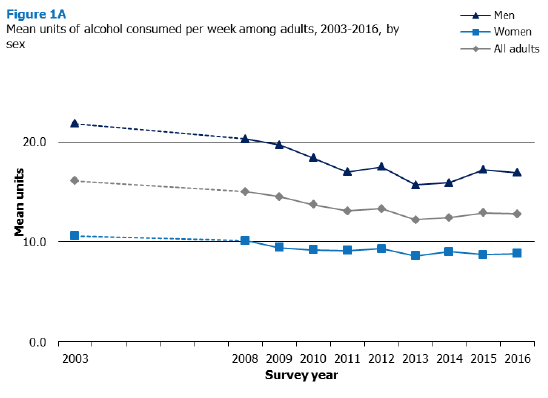
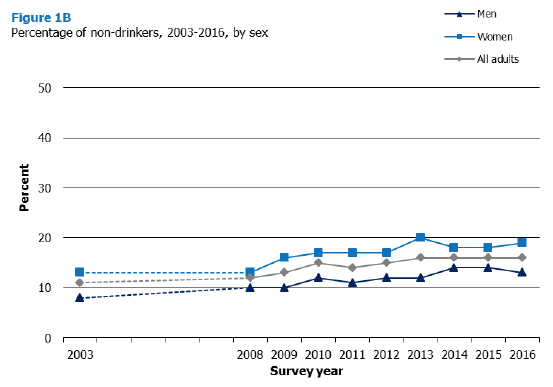
1.3.2 Usual weekly alcohol consumption in 2016, by age and sex
As in previous survey years,[37] the mean number of units of alcohol usually consumed per week was around twice as high for men (16.9 units) as for women (8.8 units) in 2016. The volume of alcohol consumed on a weekly basis varied by age group with similar patterns for men and women. Those aged 55-64 and the youngest age group (those aged 16-24) consumed the most (20.7 and 18.4 units on average, respectively for men and 10.8 and 11.3 units on average, respectively for women); the oldest age group consumed the least (12.8 units for men and 4.8 units for women).
In 2016, age-related patterns in hazardous / harmful drinking differed by sex. For men, prevalence increased with age from 32% among those aged 16-24 to 40% among those aged 55-64; the lowest prevalence was seen in those aged 75 and over (20%). For women, the highest prevalence occurred in those aged 16-24 (25%) and those aged 55-64 (23%); similarly to men, the lowest prevalence was seen in those aged 75 and over (5%).
The prevalence of non-drinking also varied significantly by age, with the lowest prevalence at 11% among those aged 16-24 (11% for men and 10% for women) and the highest prevalence at 35% among those aged 75 and over (26% for men and 41% for women).
Table 1.2
1.3.3 Usual weekly alcohol consumption in 2016, by area deprivation
The age-standardised mean units of alcohol consumed per week by drinkers in 2016 did not vary significantly by area deprivation; however patterns differed by sex. Among women, those from the least deprived quintile areas had the highest age-standardised weekly consumption (9.7 units) and those from the most deprived quintile areas had the lowest (7.5 units; Table 1.3). Among men, the pattern was slightly less clear but appeared to be the reverse of that for women: those in the least (14.5 units) and second (13.4 units) least deprived quintiles had lower consumption relative to the remaining quintiles (17.1 units to 20.6 units).
The age-standardised mean units of alcohol consumed per week by hazardous / harmful drinkers varied significantly by area deprivation in 2016. Mean units of alcohol consumed per week by hazardous / harmful drinkers was lowest in the least and second least deprived quintiles (28.8 units and 26.8 units respectively) and higher in the three most deprived quintiles (between 31.9 units and 37.2 units with the highest mean in the most deprived area). Similar patterns were found for men and women.
Table 1.3 also presents the estimated usual weekly alcohol consumption level groupings (non-drinker, moderate and harmful/hazardous drinker) by deprivation in 2016. There was a significant association between area deprivation and the consumption level categories. Patterns were particularly pronounced for women; their age-standardised prevalence of hazardous / harmful drinking declined from 20% of those in the two less deprived quintiles to 18% of those in the third and second more deprived quintiles and 11% of those in the most deprived quintile. For men, the picture was less clear: age-standardised levels of hazardous / harmful drinking were similar among the two less deprived quintiles (32-34%) and the two most deprived quintiles (30-36%) with significantly higher level among the middle area deprivation quintile (42%).
The associations between area deprivation and age-standardised non-drinking prevalence were obvious among adults in 2016 with the lowest percentage in the least deprived areas (11%) followed by a stepped increase to 26% in the most deprived area. This pattern was largely driven by women with the age-standardised percentage of women not drinking alcohol being 13% for those living in the least deprived quintile, rising steadily across the quintiles to 32% for those living in the most deprived quintile. Among men, the age-standardised non-drinking prevalence was 10-11% for those living in the less deprived three quintiles compared with 16% to 18% for those living in the more deprived two quintiles.
Prevalence of moderate drinking declined as deprivation increased (62% for the two least deprived quintiles compared to 58-55% in the three most deprived quintiles) with similar patterns for both men and women.
1.4 Alcohol Consumption On The Heaviest Drinking Day In Last Week
1.4.1 Trends since 2003 in alcohol consumption on the heaviest drinking day in last week
As shown in Table 1.4, the percentage of men drinking more than four units on their heaviest drinking day declined significantly from 2003 (45%) to 2013 (40%) and has settled at a similar level since (39% in 2016). The percentage of women drinking more than three units on their heaviest drinking day declined significantly from 2003 (37%) to 2012 (30%); since then, levels have been between 31-33%.
The percentage of men drinking more than eight units on their heaviest drinking day also declined significantly from 2003 (29%) to 2013 (24%) but has stayed at similar levels since (26% in 2015 and 24% in 2016). The trend for women drinking more than six units on their heaviest drinking day showed a significant decline from 19% in 2003 to 15% in 2012; levels have been 14-17% since then.
For all adults, the estimated mean number of units of alcohol consumed on the heaviest drinking day fell from 7.7 units in 2003 to 6.9 units in 2013, and remained at a similar level since then (7.3 units in 2016). The estimated mean number of units of alcohol consumed on heaviest drinking day for male drinkers aged 16 and over fell overall from 9.0 units in 2003 to 8.0 units in 2013. Subsequently, the mean has not changed significantly (8.3 units in 2016). The estimated mean for female drinkers aged 16 years and over fell significantly from 6.2 units in 2003 to 5.6 units in 2012 and 2013 and has risen since to 6.1 units in 2016. While this increase was not statistically significant, it may require further monitoring as it may indicate an upward trend.
Table 1.4
1.4.2 Alcohol consumption on the heaviest drinking day in last week for 2015/2016 combined
Mean units of alcohol consumed on the heaviest drinking day in the last week for 2015/2016 combined were lower with increasing age (from 10.8 units for those aged 16-24 to 3.1 for those aged 75 and over) with similar patterns for both men and women.
Male drinkers drank significantly more alcohol on their heaviest drinking day than female drinkers (8.4 units and 5.9 units on average, respectively), with higher levels seen on average for men than women at each individual age group. The mean number of units consumed on the heaviest drinking day was 12.1 for male drinkers aged 16-24 compared with 3.6 units for male drinkers aged 75 and over; the corresponding figures for female drinkers were 9.3 units and 2.5 units, respectively.
As in previous survey years[43] in 2015/2016 combined the overall percentage of men drinking more than four units on their heaviest drinking day was higher than the percentage of women drinking more than three units. This occurred both at a total level (40% and 32%, respectively) and among all age groups, see Figure 1C and Figure 1D. The percentage having at least double these numbers of units on their heaviest drinking day was also higher among men (25%) than women (15%).
Exceeding three / four units and six / eight units on the heaviest drinking day was systematically less common for the older age groups. This pattern was more pronounced for the percentage of those drinking over six or eight units (from 29% of those aged 16-24 to 2 % of those aged 75 and over) see Figure 1C, Figure 1D, Table 1.5. This pattern was evident among both men and women.
As shown in Figure 1D more than four units being consumed on the heaviest drinking day was most prevalent among men aged 16-64 (between 42% and 47%), and least prevalent among those aged 65-74 and 75 and over (35% and 14% respectively). A similar pattern was seen for women with more than three units being consumed on the heaviest drinking day by those aged 16-64 (between 36% and 39%), whereas the figures were lower for those aged 65-74 (22%) and 75 and over (7%). The percentage of men consuming more than eight units on the heaviest drinking day was higher for those aged 16-64 (between 26% and 33%) and lower for those aged 65-74 and those aged 75 and older (15% and 4% respectively). The percentage of women consuming more than six units on their heaviest drinking day was also higher for those aged 16-64 (between 13% and 26%) and lower for those aged 65-74 and 75 and older (5% and 1% respectively).
Figure 1C, Figure 1D, Table 1.5
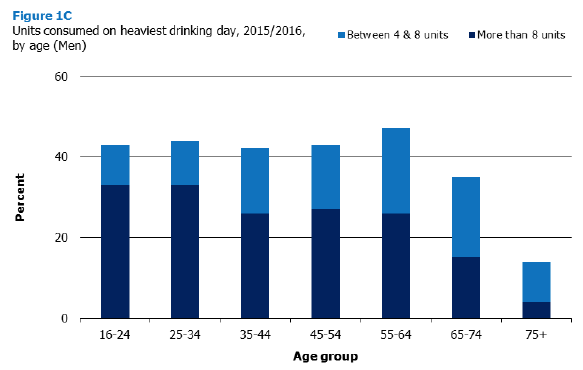
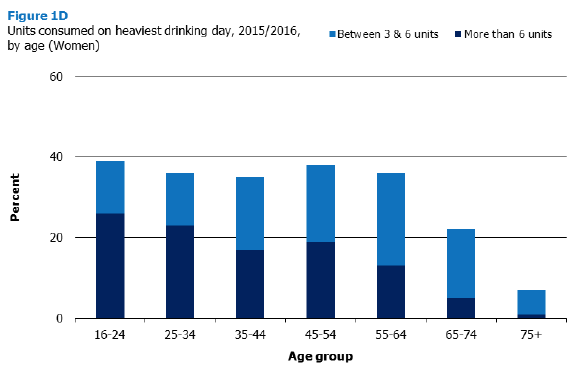
1.5 Number Of Days On Which Drank Alcohol In The Past Week
1.5.1 Trends since 2003 in the number of days on which adults drank alcohol in the past week
The mean number of days on which adults drank alcohol in the past week has remained stable since 2003, fluctuating between 2.6 and 3 days over the survey years with similarly stable trends for both men and women.
For all adults the percentage drinking alcohol on more than five days in the week prior to interview decreased significantly from 17% in 2003 to 10% in 2014, rising to 13% in 2016. Similarly, among men the percentage declined significantly from 20% in 2003 to 11% in 2014; it has since risen to 14% in 2015 and most recently 15% in 2016. Similar patterns were seen for women with a decrease from 13% in 2003 to 8% in 2014 and 2015; the level was 10% in 2016.
Table 1.6
1.5.2 The number of days on which adults drank alcohol in the past week for 2015/2016 combined
As in previous years[43], in 2015/2016 combined, the mean number of days on which alcohol was consumed increased with age (from 2.1-2.2 mean days for those aged 16-34 to 3.7 mean days for those aged 75 and over). This was true for both men and women (2.3- 2.4 days for male drinkers aged 16-34 to 4.0 for those aged 75 and over, and 2.0 days and 3.4 days respectively for women). Adults aged 75 and over had the highest number of days on which alcohol was consumed in the past week and the lowest weekly consumption levels. In combination, the data in tables 1.2, 1.5 and 1.7 suggest that older drinkers consume less at one time but with greater frequency, while younger drinkers tend to consume a greater volume of alcohol in fewer drinking sessions.
As reported for previous surveys[43] in 2015/2016 male drinkers consumed alcohol on more days per week than female drinkers (2.9 days compared with 2.4 days). The average number of days that alcohol was consumed was between 0.4 and 0.6 days higher for men than women for each age group.
Male drinkers had a significantly higher prevalence than female drinkers of drinking alcohol on more than five days in the past week (15% and 9% respectively) in 2015/2016 combined. Drinking on five days or more increased for male drinkers from 6% for those aged 16-24 to 37% for those aged 75 and over. A slightly different pattern emerged for women, with the lowest prevalence being among those aged 25-34 (1%) rising to 27% for those aged 75 and over. Prevalence for drinking on five days or more was the same for women as for men at 6%.
Table 1.7
1.5.3 The number of days on which adults drank alcohol in the past week, by area deprivation for 2015/2016 combined
There was a significant negative association between the age-standardised mean number of days on which alcohol was drunk in the week prior to interview and area deprivation for both men and women for 2015/2016: the greater the deprivation, the fewer the days on which alcohol was consumed (2.9 mean days for the least deprived quintile compared to 2.3 mean days for the most deprived quintile). A similar pattern was found for both men and women with 3.0 mean days (men) and 2.7 mean days (women) in the least deprived quintile areas compared with 2.5 mean days (men) and 2.0 mean days (women) in the most deprived quintile areas.
The age-standardised percentage of women drinking alcohol on more than five days in the week prior to interview in 2015/2016 followed a similar pattern across area deprivation quintiles (12% in the least deprived quintile areas and 6% in the most deprived quintile areas) but the picture for men was less clear.
Table 1.8
Contact
Email: Julie Landsberg, Julie Landsberg
Phone: 0300 244 4000 – Central Enquiry Unit
The Scottish Government
St Andrew's House
Regent Road
Edinburgh
EH1 3DG
There is a problem
Thanks for your feedback
